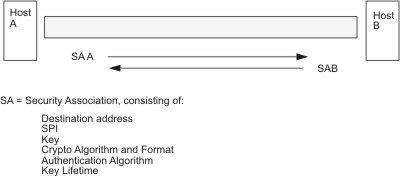Security associations
The building block on which secure communications is built is a concept known as a security association. Security associations relate a specific set of security parameters to a type of traffic.
With data protected by IP Security, a separate security association exists for each direction and for each header type, AH or ESP. The information contained in the security association includes the IP addresses of the communicating parties, a unique identifier known as the Security Parameters Index (SPI), the algorithms selected for authentication or encryption, the authentication and encryption keys, and the key lifetimes. The following figure shows the security associations between Host A and Host B.

The goal of key management is to negotiate and compute the security associations that protect IP traffic.